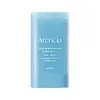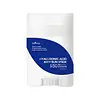What's inside
What's inside
 Key Ingredients
Key Ingredients

 Benefits
Benefits

 Concerns
Concerns

 Ingredients Side-by-side
Ingredients Side-by-side

Coco-Caprylate/Caprate
EmollientMethyl Methacrylate Crosspolymer
Synthetic Wax
AbrasiveCaprylyl Methicone
Skin ConditioningDibutyl Adipate
EmollientButyloctyl Salicylate
Skin ConditioningSilica
AbrasiveDiethylamino Hydroxybenzoyl Hexyl Benzoate
UV FilterMicrocrystalline Wax
Emulsion StabilisingEthylhexyl Triazone
UV AbsorberTocopheryl Acetate
AntioxidantOzokerite
Emulsion StabilisingPolysilicone-15
UV FilterBis-Ethylhexyloxyphenol Methoxyphenyl Triazine
Skin ConditioningTriethoxycaprylylsilane
Polyglyceryl-4 Diisostearate/Polyhydroxystearate/Sebacate
EmulsifyingBisabolol
MaskingCaprylyl Glycol
EmollientGlyceryl Caprylate
EmollientEthylhexylglycerin
Skin ConditioningTocopherol
AntioxidantWater
Skin ConditioningPanthenol
Skin ConditioningBHT
AntioxidantHydrogenated Lecithin
EmulsifyingButylene Glycol
HumectantCeramide NP
Skin ConditioningPEG-10 Rapeseed Sterol
Cleansing1,2-Hexanediol
Skin ConditioningDipropylene Glycol
HumectantOryza Sativa Extract
AbsorbentGlyceryl Stearate
EmollientGlycereth-20
HumectantGlycerin
HumectantCamellia Sinensis Leaf Extract
AntimicrobialSodium Hyaluronate
HumectantOryza Sativa Lees Extract
Skin ConditioningAnthemis Nobilis Flower Extract
MaskingLactobacillus/Rice Ferment
Skin ConditioningCentella Asiatica Extract
CleansingSodium Dna
Skin ConditioningHydrolyzed Hyaluronic Acid
HumectantDisodium EDTA
Sodium Acetylated Hyaluronate
HumectantTripeptide-1
Skin ConditioningAcetyl Hexapeptide-8
HumectantCopper Tripeptide-1
Skin ConditioningPalmitoyl Pentapeptide-4
Skin ConditioningHexapeptide-9
Skin ConditioningBromelain
Skin ConditioningOryzanol
Skin ConditioningPapain
Skin ConditioningProtease
ExfoliatingLipase
Skin ConditioningKojic Dipalmitate
EmollientCoco-Caprylate/Caprate, Methyl Methacrylate Crosspolymer, Synthetic Wax, Caprylyl Methicone, Dibutyl Adipate, Butyloctyl Salicylate, Silica, Diethylamino Hydroxybenzoyl Hexyl Benzoate, Microcrystalline Wax, Ethylhexyl Triazone, Tocopheryl Acetate, Ozokerite, Polysilicone-15, Bis-Ethylhexyloxyphenol Methoxyphenyl Triazine, Triethoxycaprylylsilane, Polyglyceryl-4 Diisostearate/Polyhydroxystearate/Sebacate, Bisabolol, Caprylyl Glycol, Glyceryl Caprylate, Ethylhexylglycerin, Tocopherol, Water, Panthenol, BHT, Hydrogenated Lecithin, Butylene Glycol, Ceramide NP, PEG-10 Rapeseed Sterol, 1,2-Hexanediol, Dipropylene Glycol, Oryza Sativa Extract, Glyceryl Stearate, Glycereth-20, Glycerin, Camellia Sinensis Leaf Extract, Sodium Hyaluronate, Oryza Sativa Lees Extract, Anthemis Nobilis Flower Extract, Lactobacillus/Rice Ferment, Centella Asiatica Extract, Sodium Dna, Hydrolyzed Hyaluronic Acid, Disodium EDTA, Sodium Acetylated Hyaluronate, Tripeptide-1, Acetyl Hexapeptide-8, Copper Tripeptide-1, Palmitoyl Pentapeptide-4, Hexapeptide-9, Bromelain, Oryzanol, Papain, Protease, Lipase, Kojic Dipalmitate
Water
Skin ConditioningPolyethylene
AbrasivePropylheptyl Caprylate
EmollientC12-15 Alkyl Benzoate
AntimicrobialHomosalate
Skin ConditioningSilica
AbrasiveEthylhexyl Methoxycinnamate
UV AbsorberNeopentyl Glycol Diheptanoate
EmollientVinyl Dimethicone/Methicone Silsesquioxane Crosspolymer
Ethylhexyl Salicylate
UV AbsorberButylene Glycol
HumectantSynthetic Fluorphlogopite
Niacinamide
SmoothingDiethylamino Hydroxybenzoyl Hexyl Benzoate
UV FilterVinyldimethicone
Bis-Ethylhexyloxyphenol Methoxyphenyl Triazine
Skin ConditioningOzokerite
Emulsion StabilisingPolyglyceryl-4 Diisostearate/Polyhydroxystearate/Sebacate
EmulsifyingPinus Pinaster Bark Extract
AntioxidantBambusa Vulgaris Water
Skin ConditioningMesembryanthemum Crystallinum Extract
HumectantHibiscus Sabdariffa Flower Extract
Skin ConditioningCeramide NP
Skin ConditioningGlycerin
HumectantOlea Europaea Fruit Oil
MaskingLaminaria Japonica Extract
Skin ProtectingUlmus Davidiana Root Extract
Skin ConditioningAloe Barbadensis Leaf Extract
EmollientViola Mandshurica Flower Extract
AntioxidantDioscorea Japonica Root Extract
Skin ConditioningPolyglyceryl-2 Dipolyhydroxystearate
Skin ConditioningPolyurethane-11
Glyceryl Caprylate
EmollientSorbitan Sesquioleate
EmulsifyingSodium Hyaluronate
HumectantAdenosine
Skin ConditioningAstaxanthin
Skin ConditioningPentylene Glycol
Skin ConditioningSodium Acetylated Hyaluronate
HumectantSodium Hyaluronate Crosspolymer
HumectantAscorbyl Propyl Hyaluronate
Skin ConditioningHydroxypropyltrimonium Hyaluronate
Hydrolyzed Sodium Hyaluronate
Skin ConditioningHydrolyzed Hyaluronic Acid
HumectantHyaluronic Acid
HumectantTriethoxycaprylylsilane
Caprylyl Glycol
EmollientEthylhexylglycerin
Skin Conditioning1,2-Hexanediol
Skin ConditioningWater, Polyethylene, Propylheptyl Caprylate, C12-15 Alkyl Benzoate, Homosalate, Silica, Ethylhexyl Methoxycinnamate, Neopentyl Glycol Diheptanoate, Vinyl Dimethicone/Methicone Silsesquioxane Crosspolymer, Ethylhexyl Salicylate, Butylene Glycol, Synthetic Fluorphlogopite, Niacinamide, Diethylamino Hydroxybenzoyl Hexyl Benzoate, Vinyldimethicone, Bis-Ethylhexyloxyphenol Methoxyphenyl Triazine, Ozokerite, Polyglyceryl-4 Diisostearate/Polyhydroxystearate/Sebacate, Pinus Pinaster Bark Extract, Bambusa Vulgaris Water, Mesembryanthemum Crystallinum Extract, Hibiscus Sabdariffa Flower Extract, Ceramide NP, Glycerin, Olea Europaea Fruit Oil, Laminaria Japonica Extract, Ulmus Davidiana Root Extract, Aloe Barbadensis Leaf Extract, Viola Mandshurica Flower Extract, Dioscorea Japonica Root Extract, Polyglyceryl-2 Dipolyhydroxystearate, Polyurethane-11, Glyceryl Caprylate, Sorbitan Sesquioleate, Sodium Hyaluronate, Adenosine, Astaxanthin, Pentylene Glycol, Sodium Acetylated Hyaluronate, Sodium Hyaluronate Crosspolymer, Ascorbyl Propyl Hyaluronate, Hydroxypropyltrimonium Hyaluronate, Hydrolyzed Sodium Hyaluronate, Hydrolyzed Hyaluronic Acid, Hyaluronic Acid, Triethoxycaprylylsilane, Caprylyl Glycol, Ethylhexylglycerin, 1,2-Hexanediol
 Reviews
Reviews

Ingredients Explained
These ingredients are found in both products.
Ingredients higher up in an ingredient list are typically present in a larger amount.
1,2-Hexanediol is a synthetic liquid and another multi-functional powerhouse.
It is a:
- Humectant, drawing moisture into the skin
- Emollient, helping to soften skin
- Solvent, dispersing and stabilizing formulas
- Preservative booster, enhancing the antimicrobial activity of other preservatives
You might know this ingredient as Tinosorb S or Bemotrizinol. It is a UV filter that covers both UVA and UVB rays.
This ingredient has two peak UV absorption peaks ( 310 and 340 nm) and is able to absorb both UV-A and UV-B rays. This ingredient works by preventing UV rays from reaching and damaging your skin.
On top of that - it is highly photostable and helps prevent the photodegration of other sunscreen ingredients such as avobenzone.
Tinosorb S is allowed in the EU, Australia, and Asia. It is close to being approved by the FDA and we'll hopefully get this ingredient in the U.S. by late 2025.
Fun fact: Tinosorb S is the most effective UV absorber at maximum concentration (measured by SPF) permitted in the EU.
This ingredient is oil-soluble, so your oil-cleansers will take this right off at night.
Learn more about Bis-Ethylhexyloxyphenol Methoxyphenyl TriazineButylene Glycol (or BG) is used within cosmetic products for a few different reasons:
Overall, Butylene Glycol is a safe and well-rounded ingredient that works well with other ingredients.
Though this ingredient works well with most skin types, some people with sensitive skin may experience a reaction such as allergic rashes, closed comedones, or itchiness.
Learn more about Butylene GlycolCaprylyl Glycol is a humectant and emollient, meaning it attracts and preserves moisture.
It is a common ingredient in many products, especially those designed to hydrate skin. The primary benefits are retaining moisture, skin softening, and promoting a healthy skin barrier.
Though Caprylyl Glycol is an alcohol derived from fatty acids, it is not the kind that can dry out skin.
This ingredient is also used as a preservative to extend the life of products. It has slight antimicrobial properties.
Learn more about Caprylyl GlycolCeramide NP is a type of ceramide and formally known as ceramide 3.
Ceramides are intercellular lipids naturally found in our skin that bonds dead skin cells together to create a barrier. They are known for their ability to hold water and thus are a great ingredient for dry skin.
Ceramides are an important building block for our skin barrier. A stronger barrier helps the skin look more firm and hydrated. By bolstering the skin ceramides act as a barrier against irritating ingredients. This can help with inflammation as well.
If you would like to eat ceramides, sweet potatoes contain a small amount.
Read more about other common types of ceramides here:
Ceramide AP
Ceramide EOP
Diethylamino Hydroxybenzoyl Hexyl Benzoate (DHHB) is a chemical UV-A absorber. It is formulated for high UVA protection (320-400 nm).
DHHB is well-liked for:
DHHB has been approved by the EU, Japan, Taiwan, and South America for use up to 10%. Unfortunately, it has not been approved for use in the US or Canada due to slow regulatory processes.
This ingredient is soluble in oils, fats, and lipids.
Learn more about Diethylamino Hydroxybenzoyl Hexyl BenzoateEthylhexylglycerin (we can't pronounce this either) is commonly used as a preservative and skin softener. It is derived from glyceryl.
You might see Ethylhexylglycerin often paired with other preservatives such as phenoxyethanol. Ethylhexylglycerin has been found to increase the effectiveness of these other preservatives.
Glycerin is already naturally found in your skin. It helps moisturize and protect your skin.
A study from 2016 found glycerin to be more effective as a humectant than AHAs and hyaluronic acid.
As a humectant, it helps the skin stay hydrated by pulling moisture to your skin. The low molecular weight of glycerin allows it to pull moisture into the deeper layers of your skin.
Hydrated skin improves your skin barrier; Your skin barrier helps protect against irritants and bacteria.
Glycerin has also been found to have antimicrobial and antiviral properties. Due to these properties, glycerin is often used in wound and burn treatments.
In cosmetics, glycerin is usually derived from plants such as soybean or palm. However, it can also be sourced from animals, such as tallow or animal fat.
This ingredient is organic, colorless, odorless, and non-toxic.
Glycerin is the name for this ingredient in American English. British English uses Glycerol/Glycerine.
Learn more about GlycerinGlyceryl Caprylate comes from glycerin and caprylic acid, a fatty acid from coconut. It has emollient and emulsifier properties.
As an emollient, it helps hydrate your skin. Emollients work by creating a barrier on your skin to trap moisture in, helping to keep your skin soft and smooth.
On the other hand, emulsifiers prevent ingredients (such as oil and water) from separating.
Learn more about Glyceryl CaprylateHydrolyzed Hyaluronic Acid is a form of hyaluronic acid. It is created by the hydrolysis of hyaluronic acid with a high molecular weight. Once created, Hydrolyzed Hyaluronic Acid has a low molecular weight.
Low molecular weight HA has been shown to hydrate and increase elasticity of the skin. Increasing elasticity is also associated with reduction of wrinkle depth.
One study found topical low molecular weight hyaluronic acid may be considered for the treatment of rosacea in the adult population. However, we always recommend speaking with a professional about your skin concerns.
Hyaluronic acids are a humectant. This means they draw moisture from the air. Hyaluronic acids help moisturize, soothe, and protect the skin.
Read more about other common forms of hyaluronic acid:
Learn more about Hydrolyzed Hyaluronic AcidOzokerite is a naturally occuring mineral wax. In cosmetics, ozokerite is used as a texture enhancer.
Ceresin wax is derived from this ingredient.
The melting point of ozokerite is 58-100 C.
Ozokerite is found all over the world including Scotland, the US, and India.
Learn more about OzokeritePolyglyceryl-4 Diisostearate/Polyhydroxystearate/Sebacate isn't fungal acne safe.
Silica, also known as silicon dioxide, is a naturally occurring mineral. It is used as a fine, spherical, and porous powder in cosmetics.
Though it has exfoliant properties, the function of silica varies depending on the product.
The unique structure of silica enhances the spreadability and adds smoothness, making it a great texture enhancer.
It is also used as an active carrier, emulsifier, and mattifier due to its ability to absorb excess oil.
In some products, tiny microneedles called spicules are made from silica or hydrolyzed sponge. When you rub them in, they lightly polish away dead skin layers and enhance the penetration of active ingredients.
Learn more about SilicaSodium Acetylated Hyaluronate is a type of Hyaluronic Acid.
Hyaluronic Acids help moisturize, soothe, and protect the skin.
Read about common types of Hyaluronic Acid here:
Sodium Hyaluronate
Hydrolyzed Hyaluronic Acid
Hyaluronic Acid
Sodium Hyaluronate is hyaluronic acid's salt form. It is commonly derived from the sodium salt of hyaluronic acid.
Like hyaluronic acid, it is great at holding water and acts as a humectant. This makes it a great skin hydrating ingredient.
Sodium Hyaluronate is naturally occurring in our bodies and is mostly found in eye fluid and joints.
These are some other common types of Hyaluronic Acid:
Learn more about Sodium HyaluronateTriethoxycaprylylsilane is a silicone used to bind and stabilize ingredients.
As an emulsifier, it helps prevent ingredients from separating. This can help elongate the shelf life of products.
Triethoxycaprylylsilane is often used to coat mineral sunscreens ingredients to help give a better feel. It also helps reduce oxidative stress in sunscreens.
Learn more about TriethoxycaprylylsilaneWater. It's the most common cosmetic ingredient of all. You'll usually see it at the top of ingredient lists, meaning that it makes up the largest part of the product.
So why is it so popular? Water most often acts as a solvent - this means that it helps dissolve other ingredients into the formulation.
You'll also recognize water as that liquid we all need to stay alive. If you see this, drink a glass of water. Stay hydrated!
Learn more about Water